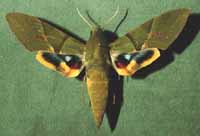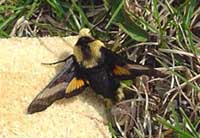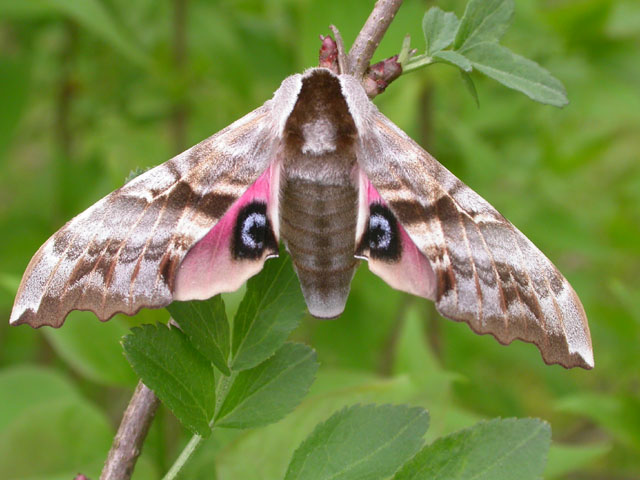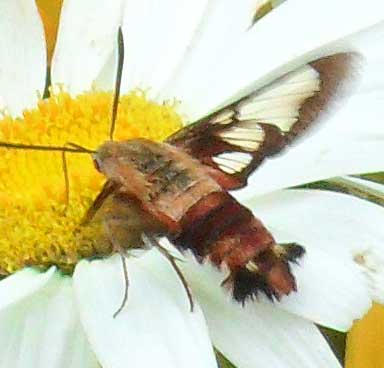Sphinginae subfamily
Sphingini tribe:
 |
This species might be enountered in Washington County as a rare
stray from much further south.
The moth is a very strong flier and
is frequently encountered far north of its usual range.
|
 |
Ceratomia amyntor
WO,
the Elm Sphinx or Four-horned Sphinx
The upperside of the forewing is brown with dark brown and white
markings including a white costal area near the wing base, dark
streaks along the veins, and a white spot in the cell.
Larvae feed on Elm (Ulmus), birch (Betula), basswood (Tilia), and
cherry (Prunus). |
 |
This is generally a more southerly species, but it may be present
where the foodplant grows.
I saw them in great numbers in New Jersey. The larvae feed in large groups and are much more
spectacular than the moths.
Catalpa is the larval host. |
 |
The upperside of the forewing is pale brownish gray with wavy black
and white lines and a black-outlined white cell spot. The upperside
of the hindwing is gray with diffuse darker bands. |
Ceratomia undulosa, (4), July 3-8, 2006, Matthew Arey
 |
The upperside of the forewing is dark brown with a dusting of white
scales. Some moths have patches of reddish or yellowish brown on the
wings.
|
Dolba hyloeus, July, 2003, Matthew Arey
 |
Lapara bombycoides
WO/MA, the
Northern Pine Sphinx
Also reported from nearby Penobscot County, it is widely
reported in Massachusetts and along the coast in New Hamshire and
Vermont. This is another one we have on P.E.I.
|
Lapara bombycoides, July, 2002-2003, Matthew Arey
 |
Forewing upperside is gray-brown with wavy lines, black dashes, and one or two small white spots near center of
the costa. Hindwing upperside is black with two white bands and a triangular black patch at the base. Note the golden hair on the thorax.
|
 |
Manduca quinquemaculatus
WO the Five-spotted Hawkmoth:
The moth abdomen usually has five but sometimes six pairs of yellow
bands. The upperside of the forewing is blurry brown and gray. The
upperside of the hindwing is banded with brown and white and has two
well-separated median zigzag bands.
|
 |
The abdomen of the adult moth has three pairs of yellow spots. The
upperside of the forewing is yellowish brown to deep chocolate brown
with a dusting of white scales and zigzagged black and white lines.
unlikely
|

|
Sphinx canadensis
MA/USGS,
Sphinx canadensis, the Canadian Sphinx, is not common, and is not
often reported anywhere,
but it is reported in Washington County.
Larval hosts are white ash (Fraxinus americana) and blueberry
(Vaccinium).
|
Sphinx canadensis, (2), July 3-8, 2006, Matthew Arey
 |
Sphinx chersis
WO, the Northern Ash Sphinx or Great Ash
Sphinx
This species is reported in nearby Penobscot County.
Larval hosts are ash, lilac, privet, cherry, and quaking aspen.
|
 |
This species is present and probably flies
in May/June and August. We have them on P.E.I., but I do not see them nearly as frequently
as I see the other Sphingidae. |
 |
This species is reported in Washington County by Matthew Arey.
I have taken them on P.E.I., Canada, and reared them on
lilac. At rest the hindwings are usually completely covered.
|
Sphinx kalmiae, (5), July 3-8, 2006, Matthew Arey
 |
Sphinx luscitiosa
WO,
the Canadian Sphinx or
Clemen's Sphinx
This one is reported from nearby Penobscot County, and it flies
to the south and west in Massachusetts. It seems to be an uncommon
species. |
 |
If you have blueberries in the woods, then you probably have the Poecila Sphinx.
They are pretty common here on Prince Edward Island, but don't fly
too far south of Massachusetts, being replaced by Sphinx gordius
in Connecticut. |
Sphinx poecila, (18), July 3-8, 2006, Matthew Arey
Smerinthini Tribe:
 |
This moth is confirmed in nearby Penobscot County.
This is the first Sphinx species I reared as a boy in New Jersey.
See the file for the female; she is different. |
 |
Pachysphinx modesta
MA, the Modest Sphinx or Poplar Sphinx
This moth is confirmed in Washington County.
They are common on Prince Edward Island. |
Pachysphinx modesta, (12), July 3-8, 2006, Matthew Arey
 |
Named for the dull grey-blue spot in the hindwing, this moth has a
wide distribution and is probably common in Washington County.
I regularly see them on Prince Edward Island, and they are reported
as far south as Florida. |
Paonias excaecata, (20 +), July 3-8, 2006, Matthew Arey
 |
Named for the small eye-spot in the hindwing, this moth has a wide
distribution and is present in Washington, confirmed by Matthew Arey.
I regularly see them on Prince Edward Island, and they are reported
as far south as Florida.
|
Paonias myops, (15), July 3-8, 2006, Matthew Arey
 |
This species probably flies throughout Maine.
At my home in Montague, P.E.I., Canada, they are quite common.
|
Smerinthus cerisyi, (7), July 3-8, 2006, Matthew Arey
 |
This moth is widely distributed and fairly common so I suspect it is
in Washington County.
Along the East Coast, it flies from P.E.I. to Florida.
|
Smerinthus jamaicensis, (12), July 3-8, 2006, Matthew Arey
Macroglossinae subfamily
Dilophonotini tribe:
See Hemaris comparison to help distinguish
the next three species.
 |
Hemaris thysbe
MA/ASBG, the Hummingbird Clearwing
This interesting day flier is confirmed for Washington County by
Matthew Arey.
They are widely distributed in the east from P.E.I. to Florida.
|
Hemaris thysbe, numerous, July 3-8, 2006, Matthew Arey
Hemaris thysbe, Lubec, July 29, 2013, Allison Smart & Bruce Greene
 |
Hemaris gracilis
WO,
The Slender Clearwing or Graceful Clearwing
This day flier is not commonly reported, but is present in
nearby Penobscot County. |
 |
Hemaris diffinis
WO/MA,
the Snowberry Clearwing or Bumblebee Moth
This moth is widely distributed and often reported north, west and
south of nearby Penobscot County as well as in Penobscot and Washington.
|
Hemaris diffinis, August, 2002, Matthew Arey
Philampelini tribe:
 |
The Gaudy Sphinx flies in America, and although primarily a tropical
species, it has been taken as far north as Saskatchewan as a stray.
Forewings are a vibrant grey-green. rare stray
|
Macroglossini tribe:
 |
This day flier is widely distributed. If you have Virginia Creeper,
you probably have the Nessus Sphinx.
Two bright, distinct,
narrow yellow bands are often visible on the abdomen.
|
 |
They are common in New Jersey and common
here on Prince Edward Island.
You will often see this species listed as Darapsa pholus,
especially in older literature. |
Darapsa choerilus, (1), July 3-8, 2006, Matthew Arey
 |
Darapsa myron WO, the Virginia Creeper Sphinx or the Grapevine Sphinx
This moth is not recorded on the U.S.G.S. site for Washington County,
but it is widely reported as far north as southern Maine. If you have
the foodplants indicated in the common names, you may have this species nearby.
|
 |
If you have hydrangea growing near a stream, then you may have the
Hydrangea Sphinx. This
species has a range generally more to the south.
|
 |
Hyles gallii
WO/MA, the Bedstraw Hawk Moth
or Gallium Sphinx
This species is also reported in nearby Penobscot County.
Some years I see them on P.E.I., some years, I do not.
|
Hyles gallii intermedia, August, 2005, Matthew Arey
 |
Hyles lineata
WO, the White-lined Sphinx
This species is reported from nearby Penobscot County.
It is a strong migrator from the south,
and there are records from the west and to the north. non-resident stray |
 |
This species is reported from Penobscot County by Matthew Arey.
Adults fly as a single brood from April-June-early July in meadows in
coniferous forests. Adults fly during the afternoon.
|
Proserpinus flavofasciata, one, nectaring at lupine, July 3-8, 2006, Matthew Arey
 |
This moth is very much under reported. It is a
rapid day flier so is probably not in too many collections.
Grape is a popular larval host.
|
|
|


